2021 Tesla Model Y Tire Care and Maintenance
Displaying Tire Pressures
Display tire pressures on the touchscreen by touching . The pressure of each tire displays in the visualization of your Model Y. You can choose whether you want to display tire pressures using Bar or PSI by touching .
Maintaining Tire Pressures
Keep tires inflated to the pressures shown on the Tire and Loading Information label, even if it differs from the pressure printed on the tire itself. The Tire and Loading Information label is located on the center door pillar and is visible when the front door is open.
If you are towing a trailer, do not use the tire pressures printed on the Tire and Loading Information Label. Instead, refer to the tire pressures published in the towing section (see Towing and Accessories).
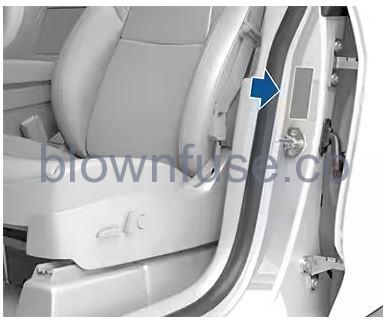
 The Tire Pressure indicator light on the touchscreen alerts you if one or more tires is under-inflated.
The Tire Pressure indicator light on the touchscreen alerts you if one or more tires is under-inflated.The Tire Pressure indicator light does not immediately turn off when you adjust tire pressure. After inflating the tire to the recommended pressure, you must drive over 15 mph (25 km/h) for a short amount of time to activate the Tire Pressure Monitoring System (TPMS), which turns off the Tire Pressure indicator light.
If the indicator light flashes for one minute whenever you power on Model Y, a fault with the TPMS is detected (see TPMS Malfunction).
Checking and Adjusting Tire Pressures
Follow these steps when tires are cold and Model Y has been stationary for over three hours:
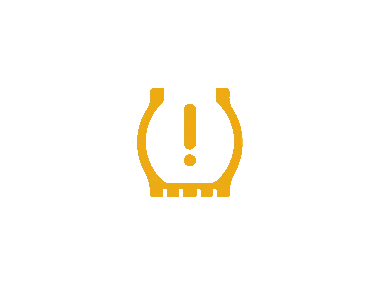
- Refer to the Tire and Loading Information label located on the driver’s center door pillar for the target tire pressure.
- Remove the valve cap.
- Firmly press an accurate tire pressure gauge onto the valve to measure pressure.
- If required, add or remove air to reach the recommended pressure.
NoteYou can release air by pressing the metal stem in the center of the valve.
- Re-check pressure using the accurate tire gauge.
- Repeat steps 3 and 4 as necessary until the tire pressure is correct.
- Reinstall the valve cap to prevent dirt from entering. Periodically check the valve for damage and leaks.
Inspecting and Maintaining Tires
Regularly inspect the tread and side walls for any sign of distortion (bulges), foreign objects, cuts or wear.
Tire Wear
Adequate tread depth is important for proper tire performance. Tires with a tread depth less than 4/32” (3 mm) are more likely to hydroplane in wet conditions and should not be used. Tires with a tread depth less than 5/32” (4 mm) do not perform well in snow and slush and should not be used when driving in winter conditions.
Model Y is originally fitted with tires that have wear indicators molded into the tread pattern. When the tread has been worn down to 4/32” (3 mm), the indicators start to appear at the surface of the tread pattern, producing the effect of a continuous band of rubber across the width of the tire. For optimal performance and safety, Tesla recommends replacing tires before the wear indicators are visible.
Tire Rotation, Balance, and Wheel Alignment
Tesla recommends rotating the tires every 6,250 miles (10,000 km) or if tread depth difference is 2/32 in (1.5 mm) or greater, whichever comes first.
If Model Y comes with staggered wheels, tires cannot be rotated, as tires are asymmetrical and front tires are a different size from rear tires.
Unbalanced wheels (sometimes noticeable as vibration through the steering wheel) affect vehicle handling and tire life. Even with regular use, wheels can get out of balance. Therefore, they should be balanced as required.
If tire wear is uneven (on one side of the tire only) or becomes abnormally excessive, check the alignment of wheels.
Punctured Tires
A puncture eventually causes the tire to lose pressure, which is why it is important to check tire pressures frequently. Permanently repair or replace punctured or damaged tires as soon as possible.
Your tubeless tires may not leak when penetrated, provided the object remains in the tire. If, however, you feel a sudden vibration or ride disturbance while driving, or you suspect a tire is damaged, immediately reduce your speed. Drive slowly, while avoiding heavy braking or sharp steering and, when safe to do so, stop the vehicle. Arrange to have Model Y transported to a Tesla Service Center, or to a nearby tire repair center.
Flat Spots
If Model Y is stationary for a long period, tires can form flat spots. When Model Y is driven, these flat spots cause a vibration which gradually disappears as the tires warm up and regain their original shape.
To minimize flat spots during storage, inflate tires to the maximum pressure indicated on the tire wall. Then, before driving, release air to adjust tire pressure to the recommended levels.
Improving Tire Mileage
To improve the mileage you get from your tires, maintain tires at the recommended tire pressures, observe speed limits and advisory speeds, and avoid:
- Pulling away quickly, or hard acceleration.
- Fast turns and heavy braking.
- Potholes and objects in the road.
- Hitting curbs when parking.
- Contaminating tires with fluids that can cause damage.
Replacing Tires and Wheels
Tires degrade over time due to the effects of ultraviolet light, extreme temperatures, high loads, and environmental conditions. It is recommended that tires are replaced every six years, or sooner if required, even if tread depth is above the minimum.
Wheel and tires are matched to suit the handling characteristics of the vehicle. Replacement tires must comply with the original specification. If tires other than those specified are used, ensure that the load and speed ratings marked on the tire (see Understanding Tire Markings) equal or exceed those of the original specification.
When a tire set becomes worn, replace all four tires at the same time. If tires need to be replaced early, we recommend replacing the tires in pairs unless the other tires are fairly new (for example, minimal wear relative to the new tire). Place the new tires on the rear if all four tires are of the same size. Always balance the wheel and tire after replacing a tire. Consult with a professional tire retailer and installer for further guidance.
If you replace a wheel, the TPMS (Tire Pressure Monitoring System) sensors need to be reset to ensure they provide accurate warnings when tires are under-inflated (see Automatic Reset of TPMS Sensors).
For the specification of the original wheels and tires installed on Model Y, see Wheels and Tires.
Asymmetric Tires
Model Y tires are asymmetric and must be mounted on the wheel with the correct sidewall facing outward. The sidewall of the tire is marked with the word OUTSIDE. When new tires are installed, make sure that the tires are correctly mounted on the wheels.
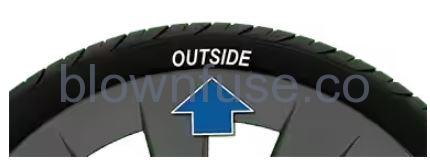
Removing and Installing Aero Covers
If your Model Y is equipped with aero covers, you must remove them to access the lug nuts.
To remove an aero cover:
- Grasp the aero cover firmly with both hands.
- Pull the aero cover toward you to release the retaining clips.
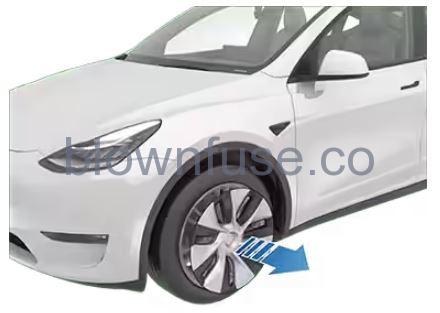
To install an aero cover:
- Align the aero cover into position so that the notch at the base of the Tesla “T” is aligned with the tire’s valve stem.
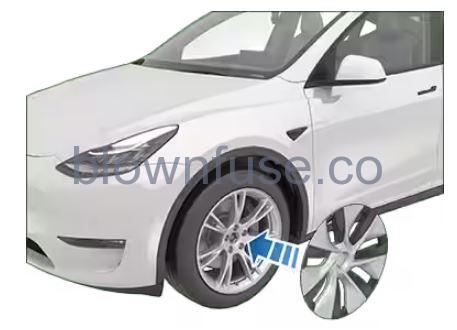
- Push firmly around the perimeter of the aero cover until it fully snaps into place.
For Gemini wheels, press on the perimeter of the cover until it aligns with the wheel surface. Press on the Tesla “T” in the center until the cap snaps into place. See Parts and Accessories for more information.
CAUTIONTo prevent the aero cover from falling off, ensure that it is fully secured before driving.
Removing and Installing Lug Nut Covers
If your Model Y is equipped with lug nut covers, you must remove them to access the lug nuts.
To remove a lug nut cover:
- Place the curved part of the lug nut cover tool (located in the glovebox for some vehicles, or you can use a small allen wrench) into the lowered perimeter around the middle of the lug nut cover.
NoteThe lug nut cover tool can also be purchased at an auto parts store or through online retailers.
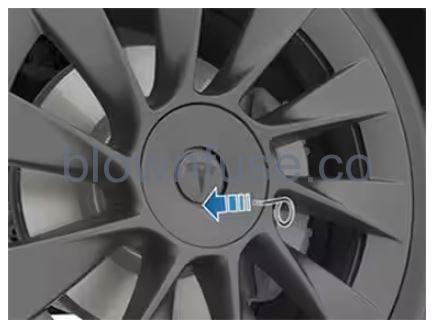
- Twist the lug nut cover tool so that the end of the curved part is facing away from the Tesla “T”.
- Firmly pull the lug nut tool away from the wheel until the lug nut cover is released.
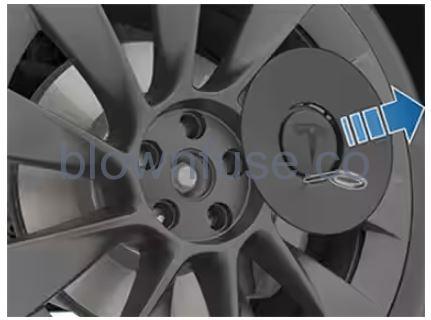
To install the lug nut cover:
- Align the lug nut cover into position.
- Push firmly on the lug nut cover until it fully snaps into place.
CAUTIONMake sure the lug nut cover is fully secure before driving to prevent it from falling off.
Tire Pressure Monitoring
Each tire should be checked monthly when cold and inflated to the recommended pressures that are printed on the Tire and Loading Information label located on the driver’s door pillar (see Maintaining Tire Pressures). If your vehicle has tires of a different size than the size indicated on the vehicle placard or tire inflation pressure label, determine the proper tire inflation pressure for those tires.
As an added safety feature, your vehicle has been equipped with a TPMS that displays a tire pressure telltale (Tire Pressure Warning) on the touchscreen when one or more of your tires is significantly under-inflated. Accordingly, when the Tire Pressure indicator light displays on the touchscreen to alert you about tire pressure, stop and check your tires as soon as possible, and inflate them to the proper pressure (see Maintaining Tire Pressures). Driving on a significantly under-inflated tire causes the tire to overheat and can lead to tire failure. Under-inflation also reduces range efficiency and tire tread life, and may affect the vehicle’s handling and stopping ability.
Automatic Reset of TPMS Sensors
After replacing one or more wheels (but not after replacing a tire), the TPMS sensors are relearned to ensure tire pressure warnings are accurate. TPMS sensors reset automatically within two minutes of driving over 15 mph (25 km/h).
Replacing a Tire Sensor
If the Tire Pressure warning indicator displays frequently, contact Tesla to determine if a tire sensor needs to be replaced. If a non-Tesla Service Center repairs or replaces a tire, the tire sensor may not work until Tesla performs the setup procedure.
TPMS Malfunction
Model Y has also been equipped with a TPMS malfunction indicator to indicate when the system is not operating properly.

TPMS malfunctions can occur for a variety of reasons, including installing replacement or alternate tires or wheels that prevent the TPMS from functioning properly. Always check the TPMS malfunction indicator light after replacing one or more tires or wheels on your vehicle to ensure that the replacement tires or wheels allow the TPMS to continue to function properly.
Seasonal Tire Types
Understand Your Tire Type
The type of tires that your vehicle is originally equipped with depends on vehicle model and market region. It is important to understand the capabilities of your vehicle’s tires and whether they are suited for summer, all-season, or winter driving. Check the information on the sidewall of a tire for information about a tire’s performance characteristics (see Understanding Tire Markings)
Summer and All-Season Tires
Summer tires and all season tires are designed for maximum dry and wet road performance but are not designed to perform well in winter conditions. All-season tires are designed to provide adequate traction in most conditions year-round, but may not provide the same level of traction as winter tires in snowy or icy conditions. All-season tires can be identified by “ALL SEASON” and/or “M+S” (mud and snow) on the tire sidewall.
If driving in cold temperatures or on roads where snow or ice may be present, Tesla recommends using winter tires. If not equipped with winter tires, contact Tesla for winter tire recommendations.
Winter Tires
Use winter tires to increase traction in snowy or icy conditions. When installing winter tires, always install a complete set of four tires at the same time. Winter tires must be the same diameter, brand, construction and tread pattern on all four wheels. Contact Tesla for winter tire recommendations.

When driving with winter tires, you may experience more road noise, shorter tread life, and less traction on dry roads.
Driving in Low Temperatures
Tire performance is reduced in low ambient temperatures, resulting in reduced grip and an increased susceptibility to damage from impacts. Performance tires (summer applications) have reduced traction in ambient temperatures below 40° F (5° C), and are not recommended in snow/ice conditions. Performance tires can temporarily harden when cold, causing you to hear rotational noise for the first few miles (kilometers) until the tires warm up.
Using Tire Chains
Tesla has tested and approved the following tire chains to increase traction in snowy conditions. Tire chains should only be installed on the rear tires. The approved tire chains can be purchased from Tesla.
| Tire Size | Recommended Chain |
|---|---|
| 19″/20″ | KONIG XG-12 PRO SIZE 252 |
| 21″ | KONIG K-SUMMIT XXL K66 |
When installing tire chains, follow the instructions and warnings provided by the tire chain manufacturer. Mount them evenly and as tight as possible.
When using tire chains:
- Inspect the tire chains for loose fittings and damaged links before each use.
- Avoid heavily loading Model Y (heavy loads can reduce the clearance between the tires and the body).
- Do not drive the vehicle without the chains properly installed.
- Drive slowly. Do not exceed 30 mph (48 km/h).
- Remove the tire chains as soon as conditions allow.


